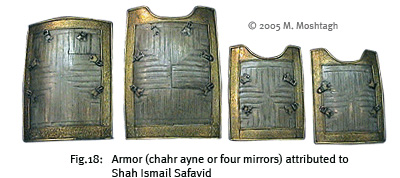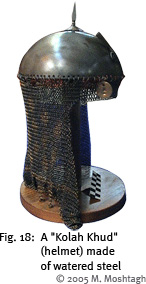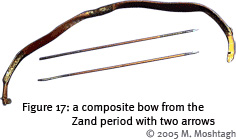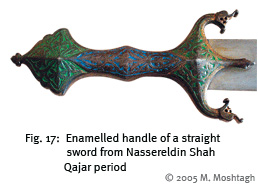|
|
|
Arms & Armor from Iran: The Bronze Age to the End of the Qajar Period An exceptionally great book by: Manouchehr Khorasani Review by: Dr. Kaveh Farrokh I would like to take the opportunity to introduce a book that stands among the premier works if scholarship in Iranian studies and history. This is Manoucher Mostagh Khorasani’s book; Contact Information: info@legat-publishers.com
Manouchehr Khorasani
This book stands amongst the greatest books ever produced in its field; it is veritably at the caliber of the late Professor Roman Ghirschman. This scholarly book examines the development of metalwork technology and associated developments in arms and armor from the ealiest Aryan arrivals onto the Iranian plateau. What is significant is that Khorasani fully acknowledges the role of regions such as Marlik and Lursitan in the development of technology in Iran. However, Khorasani has not confined his work to metalworks, technology and armaments. He fully acknowledges the role of the arts in the context of these developments. This breathtaking book is contains 2500 color photos never before seen in western academia nor even in much of Iran itself. This book will be a MAJOR reference source of scholars for years to come. It was in pre-Achaemenid era (especially the Mede era) where much of the basis of the “Persepolis Arts” was first laid. Iranian Zoroastrian motifs began to appear in earnest in the metalworks of places such as Lursitan. Examples include mythological bird-beasts appearing on equestrian equipment (e.g. horse bits), daggers, and other metalworks. These motifs were to exert a profound influence on later European and Far eastern arts. These include the lion motif seen in the Achaemenid Akenakes dagger:
Akenakes-Ach ]
The lion motif continues to be a potent symbol of collective Iranian identity. It is motif that has exerted a powerful legacy in Europe as outlined by the late Roman Ghirschman. The development of technology in Iran was to exert a lasting legacy on world history. While Achaemenid Persia did fail to conquer Greece and Alexander conquered the Persian Empire of Darius III, technological developments in Persia continued to proceed. Khorasani fully expostulated upon those developments, especially in the context of archery equipment, swords and blade weapons, and other weapons such as lances, spears and javelins. These weapons however also exhibit the development of the arts of Iran, motifs that trace their developments back to the early Aryan, Mede and Achaemenid eras. Armor and metalworks not only continued their developments in the post-Islamic period, but alos experienced a renaissance in the Safavid era (1501-1736). Note the rare photograph of the armor of Shah Ismail (ruled 1501-1524), the founder of the dynasty: Armor Shah Ismail
The “Spangenhelm” helmets of riveted construction metallic plates, which reached a high level of sophistication in the Sassanian era, gave way to more advanced designs in post-Islamic Iran:
Kulah-Khud
The Zand era is of profound importance to Iranians, however few know of the historical events of the period. It was Karim Khan Zand (1705-1779), the founder of the dynasty who, expelled the Pathan invaders of Iran. Many of Karim Khan Zand’s warriors, included women, mainly the wives and daughters of the Luristan warriors. Their archery equipment was of the highest quality (see below):
Zand-Archery
The Zands may have introduced line firing (alternate volleys fired by succeeding rows). This technique had been known in Persia since the days of the Medes and Achaemenids. The Qajar period (1781-1925) witnessed the construction of the some the highest quality metalworks (notably in swords and shields). Much of this is unknown as the Qajars are associated with the defeats suffered against imperial Russian expansions in the Caucasus and Central Asia in the late 1700s-early 1800s. Irrespective of the Qajar political leadership which was militarily inept and politically corrupt, the swords, armor and associated artistry were highly advanced. Note the examples below:
Sword-Qajar
Note the color motifs applied to the sowrd handle. These colors (and their combination) are not unlike those seen in the Sassanian era. Note also the manner in which the blade attaches to the handle. Khorasani has sacrificed much to write this comprehensive text. He conducted in full-time research and travels with his own expense for over a decade – Khorasani conducted this project under his own personal initiative. This is the characteristic of world class scholars whose passion for their research transcends all personal motives in the quest to disseminate knowledge to humanity. On a final note, I highly recommend this book to those interested to learn about the history of Iran from the Aryan arrivals to the end of the Qajar era, especially with respect to metalwork technology and associated arts. ------------------------------------------------------------------------------------------------- Dr. Kaveh Farrokh: Historian of Pre-Islamic Persia (Continuing Studies – University of British Columbia) Member of WAIS (World Association of International Studies) at Stanford University Member of Persian Gulf Organization Member of the Iranian Linguistics Society |





